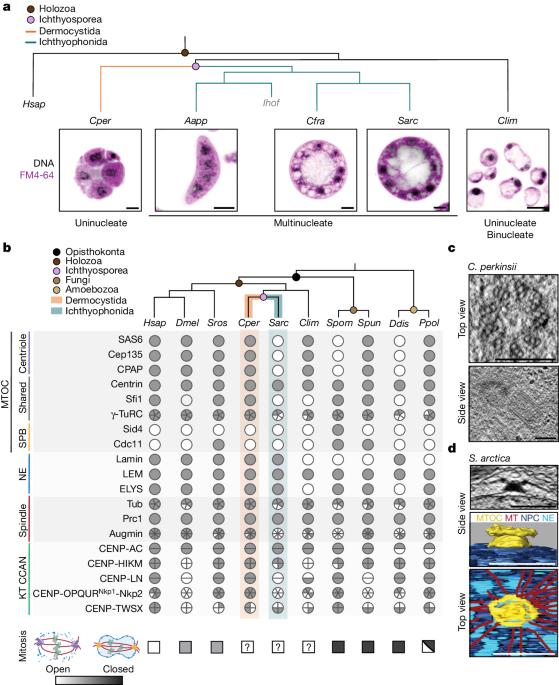Evolutionary Divergence of Mitotic Strategies in Ichthyosporea, Close Relatives of Animals and Fungi
Core Concepts
Eukaryotes have evolved towards either an open mitosis with nuclear envelope disassembly or a closed mitosis with intranuclear spindle construction, and this divergence is likely driven by the need to support distinct multinucleated or uninucleated cellular states in Ichthyosporea.
Abstract
The article investigates the evolutionary reasons behind the two main strategies for remodeling the nuclear envelope during cell division in eukaryotes - open mitosis with nuclear envelope disassembly, and closed mitosis with intranuclear spindle construction. Using a comparative genomics and ultrastructural imaging approach, the authors focus on the mitotic strategies in Ichthyosporea, a group of organisms closely related to animals and fungi.
The key findings are:
Ichthyosporea species have diverged towards either a fungal-like closed mitosis or an animal-like open mitosis.
This divergence is likely driven by the need to support distinct multinucleated or uninucleated cellular states in these organisms.
The results suggest that multinucleated life cycles favor the evolution of closed mitosis.
The article provides insights into how the core division machinery and nuclear envelope remodeling strategies have evolved in close relatives of animals to accommodate different cellular organization requirements.
Life-cycle-coupled evolution of mitosis in close relatives of animals - Nature
Stats
Eukaryotes have evolved towards one of two extremes along a spectrum of strategies for remodelling the nuclear envelope during cell division.
Both classes of mitotic remodelling involve key differences in the core division machinery.
Quotes
"Eukaryotes have evolved towards one of two extremes along a spectrum of strategies for remodelling the nuclear envelope during cell division: disassembling the nuclear envelope in an open mitosis or constructing an intranuclear spindle in a closed mitosis."
"Our results indicate that multinucleated life cycles favour the evolution of closed mitosis."
Key Insights Distilled From
by Hiral Shah,M... at www.nature.com 05-22-2024
https://www.nature.com/articles/s41586-024-07430-z
Deeper Inquiries
What are the specific molecular and structural differences in the core division machinery between the open and closed mitosis strategies observed in Ichthyosporea?
In Ichthyosporea, the core division machinery differs significantly between open and closed mitosis strategies. In open mitosis, which is more animal-like, the nuclear envelope disassembles completely, allowing the spindle apparatus to interact directly with the chromosomes. This process involves the breakdown of the nuclear envelope through phosphorylation of nuclear pore complexes and disassembly of the nuclear lamina. On the other hand, closed mitosis, resembling the fungal strategy, involves the formation of an intranuclear spindle within the intact nuclear envelope. This mechanism requires the spindle to navigate through the nuclear pores, maintaining the nuclear envelope's integrity throughout the process. Additionally, closed mitosis in Ichthyosporea involves the presence of a modified nuclear envelope that facilitates spindle assembly and chromosome segregation within the nucleus.
How do the evolutionary pressures driving the divergence of mitotic strategies in Ichthyosporea compare to those in other eukaryotic lineages?
The evolutionary pressures leading to the divergence of mitotic strategies in Ichthyosporea can be compared to those in other eukaryotic lineages. In Ichthyosporea, the choice between closed and open mitosis appears to be linked to the organism's life cycle, with multinucleated states favoring closed mitosis and uninucleated states favoring open mitosis. This suggests that the evolution of mitotic strategies in Ichthyosporea is driven by the need to support different life cycle stages efficiently. In contrast, other eukaryotic lineages may have evolved mitotic strategies based on factors such as cell size, nuclear size, metabolic requirements, or environmental conditions. The specific molecular and structural differences in the core division machinery between open and closed mitosis in Ichthyosporea reflect the unique evolutionary pressures acting on this clade.
What insights can the mitotic strategies of Ichthyosporea provide into the early evolution of multicellularity and complex life cycles in eukaryotes?
The mitotic strategies observed in Ichthyosporea provide valuable insights into the early evolution of multicellularity and complex life cycles in eukaryotes. The divergence towards closed mitosis in species with multinucleated life cycles suggests that this strategy may have facilitated the coordination of nuclear divisions within a shared cytoplasm, leading to the formation of multinucleated structures. This could be a crucial step towards the evolution of multicellularity, where multiple nuclei can function cooperatively within a single organism. Additionally, the presence of both fungal-like closed mitosis and animal-like open mitosis in Ichthyosporea indicates a flexibility in mitotic strategies that may have been advantageous for adapting to diverse environmental conditions and life cycle requirements during early eukaryotic evolution.
0
